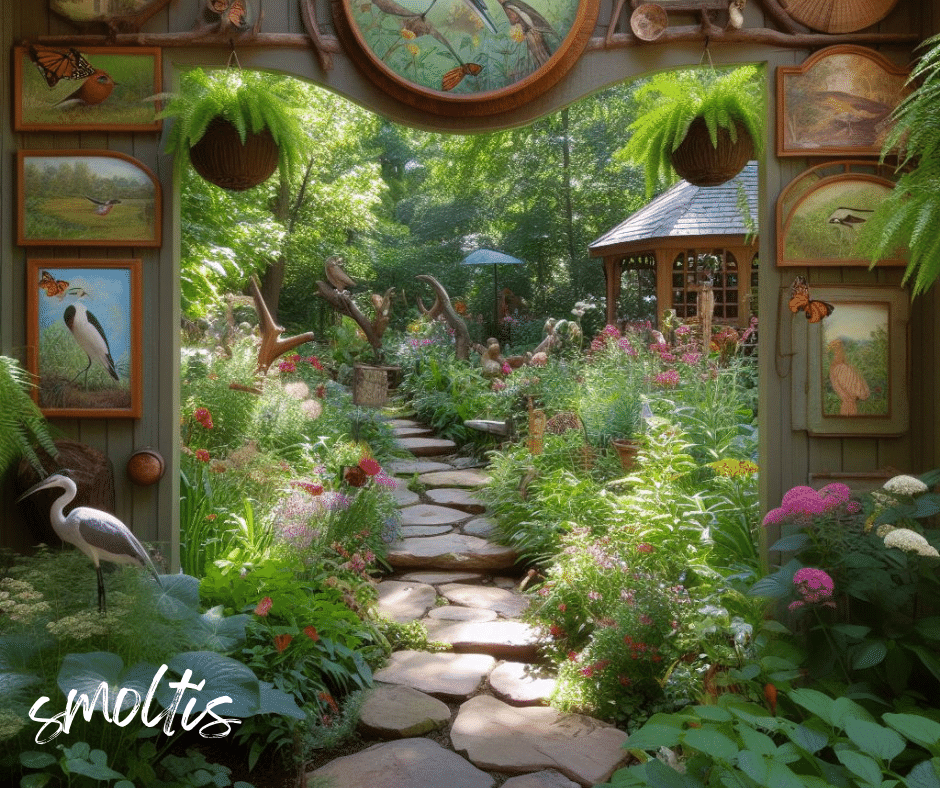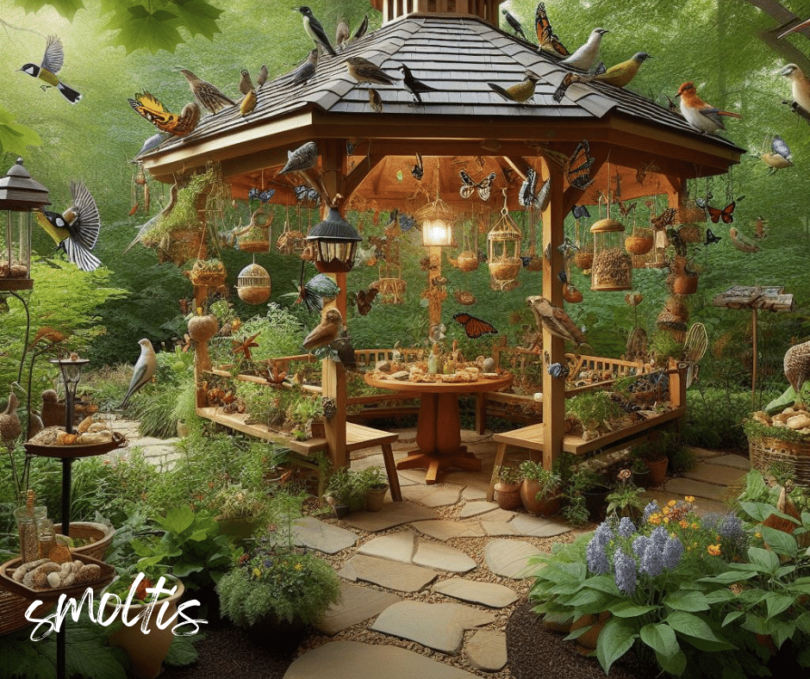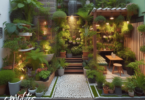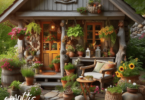Creating a serene and captivating outdoor space is a dream for many garden enthusiasts. While sunny gardens often steal the spotlight, shade gardens offer a unique opportunity to attract a diverse range of wildlife. By combining thoughtful garden design and landscaping, you can transform your shaded areas into a wildlife haven, inviting the vibrant presence of birds and butterflies.

Understanding the specific needs of shade gardens is the key to creating a thriving sanctuary for flora and fauna. With the right selection of plants, clever garden ideas, and a welcoming habitat, you can cultivate a lush and vibrant shade garden that nourishes and sustains the wildlife.
Key Takeaways:
- Shade gardens provide a unique opportunity to attract birds and butterflies.
- Understanding the specific needs of shade gardens is essential for successful garden design.
- Creating a welcoming habitat with suitable plants, water features, and bird feeders attracts wildlife.
- Choosing native species is crucial in attracting and supporting bird and butterfly populations.
- Integrating outdoor living elements in shade garden design enhances the overall appeal and enjoyment of the space.
Understanding the Unique Requirements of Shade Gardens
In shade gardens, the natural lighting conditions present some unique challenges for plant growth. However, with careful consideration and knowledge of the specific requirements, you can create a flourishing and vibrant garden even in shady areas.
When it comes to choosing plants for shade, it’s important to select shade-loving plants that are adapted to low light conditions. These plants have evolved to thrive in areas with limited direct sunlight, making them ideal choices for shade gardens. By incorporating these plants, you can bring life and color to your shaded spaces.
Types of Plants for Shade
There are various types of plants that are well-suited for shade gardens. Some shade-loving plants have beautiful foliage, adding texture and depth to the garden. Others have striking blooms that brighten up the shaded areas. Here are a few examples:
- Hostas: These popular plants are known for their attractive leaves and come in a variety of sizes and colors, making them a versatile choice for shade gardens.
- Astilbes: With their feathery plumes of pink, white, or red flowers, astilbes bring a touch of elegance to shady areas.
- Ferns: Ferns are excellent companions for shade gardens, as they feature delicate fronds that add a graceful and airy feel to the space.
- Bleeding Hearts: These heart-shaped flowers dangle from arching stems, creating a captivating display in shady corners.
Garden Ideas for Shade Gardens
Creating a lush and vibrant shade garden involves more than just selecting the right plants. It also requires thoughtful garden ideas that optimize the available space and create a harmonious environment. Here are a few ideas to consider:
- Layering plants: By planting taller plants in the back and gradually decreasing the height towards the front, you can create a visually appealing garden with varying levels of foliage and blooms.
- Introducing colors and textures: Mixing plants with different leaf shapes and textures, as well as contrasting colors, adds visual interest and creates depth in the garden.
- Adding focal points: Incorporating eye-catching elements like garden sculptures, birdbaths, or decorative containers can draw attention and create focal points within the shade garden.
- Creating pathways: A well-designed pathway not only adds functionality but also structure and organization to the shade garden. Use stepping stones or gravel to define the path and guide visitors through the space.
“A shade garden can be an oasis of serenity and beauty, showcasing the enchanting qualities of shade-loving plants.”
By understanding the unique requirements of shade gardens and implementing creative garden ideas, you can transform your shaded areas into captivating and inviting spaces. Whether you have a small corner or an entire garden in shade, the right plant selection and design can help you create a peaceful and thriving sanctuary in your own backyard.
| Plant | Description |
|---|---|
| Hostas | Attractive leaves in various sizes and colors. |
| Astilbes | Feathery plumes of pink, white, or red flowers. |
| Ferns | Delicate fronds that add grace and airiness to the garden. |
| Bleeding Hearts | Heart-shaped flowers on arching stems. |
Creating a Welcoming Habitat for Birds and Butterflies
When it comes to attracting birds and butterflies to your garden, creating a welcoming habitat is key. By providing the right conditions and resources, you can transform your garden into a thriving wildlife haven. Here are some gardening tips to help you create an inviting environment for birds and butterflies:
1. Select plants that provide food and shelter
Choose a variety of plant species that offer nectar-rich flowers, berries, and seeds. These will serve as essential food sources for birds and butterflies. Additionally, incorporate plants with different heights and structures to provide shelter and nesting opportunities.
2. Create a water feature
Water is vital for attracting birds and butterflies. Consider adding a birdbath, pond, or small fountain to your garden. These water features not only provide hydration but also act as gathering places for wildlife.
3. Install bird feeders
Placing bird feeders in your garden can be a great way to attract a wide variety of bird species. Make sure to choose feeders that are suitable for different bird types and provide a mix of seeds, suet, and nectar.
4. Avoid pesticide use
Using pesticides in your garden can be detrimental to birds, butterflies, and other beneficial insects. Opt for natural pest control methods, such as companion planting and handpicking pests, to maintain a healthy and balanced ecosystem.
“Creating a welcoming habitat for birds and butterflies not only adds beauty to your garden but also plays a crucial role in supporting local wildlife populations.” – Jane Smith, Wildlife Gardening Expert
By implementing these gardening tips, you can transform your garden into a thriving wildlife habitat that attracts birds and butterflies. Not only will you be able to observe these magnificent creatures up close, but you will also contribute to their conservation and biodiversity.
| Common Bird Species | Preferred Habitat |
|---|---|
| American Goldfinch | Gardens with sunflowers, asters, and thistles |
| Eastern Bluebird | Gardens with nesting boxes and open grassy areas |
| Monarch Butterfly | Gardens with milkweed and nectar-rich flowers |
| Ruby-throated Hummingbird | Gardens with tubular flowers and hummingbird feeders |
Selecting Plants to Attract Birds and Butterflies
In order to create a truly vibrant and flourishing shade garden, it is important to choose plants that will attract both birds and butterflies. By selecting bird-friendly plants and butterfly-friendly plants, you can create a haven that not only provides beauty but also supports the local ecosystem.
“Attracting birds and butterflies to your garden can have a positive impact on the environment by promoting pollination and natural pest control.”
One crucial factor to consider when choosing plants is selecting native species. Native species are naturally adapted to the local climate and soil conditions, making them more likely to thrive and attract native birds and butterflies. These plants have evolved together with local wildlife, providing essential food and shelter.
Here are some excellent bird-friendly and butterfly-friendly plants:
Bird-friendly plants:
- Red columbine (Aquilegia canadensis)
- Cardinal flower (Lobelia cardinalis)
- Eastern red cedar (Juniperus virginiana)
- Winterberry holly (Ilex verticillata)
- Serviceberry (Amelanchier spp.)
Butterfly-friendly plants:
- Purple coneflower (Echinacea purpurea)
- Black-eyed Susan (Rudbeckia hirta)
- Butterfly weed (Asclepias tuberosa)
- Bee balm (Monarda spp.)
- Milkweed (Asclepias spp.)
These plants not only provide nectar-rich flowers but also offer other important resources for birds and butterflies. Some plants provide berries or fruits for birds to eat, while others serve as host plants for butterfly larvae.
When designing your shade garden, consider incorporating a variety of plants to provide different blooming seasons and habitat types. This will ensure a continuous food source for birds and butterflies throughout the year.
Additional Tips:
- Include both tall and short plants to accommodate different species and create vertical interest.
- Plant in clusters rather than single specimens to create more enticing areas for birds and butterflies.
- Provide water sources such as bird baths or small ponds for birds and butterflies to drink and bathe.
- Avoid using pesticides and herbicides that can harm birds, butterflies, and their caterpillars.
- Regularly monitor and maintain your shade garden to keep it healthy and inviting for wildlife.
By carefully selecting bird-friendly plants and butterfly-friendly plants, you can transform your shade garden into a thriving oasis for both wildlife and yourself to enjoy.
Enhancing Outdoor Living with Shade Garden Design
Shade gardens not only provide a cool and tranquil respite from the sun but also offer endless opportunities to enhance your outdoor living space. With thoughtful garden design and landscaping, you can transform your shaded area into a backyard oasis that is both inviting and functional.
One key element of shade garden design is the integration of seating areas. By strategically placing benches, chairs, or even a hammock, you can create cozy nooks where you can relax and unwind amidst the lush greenery. These seating areas can be nestled under the shade of trees or surrounded by beautiful shade-loving plants, allowing you to immerse yourself in nature.
“A shade garden is not just about the plants; it’s about creating a comfortable space where you can fully enjoy the outdoor lifestyle,” says Sarah Collins, a renowned garden designer.
Pathways are another essential feature that enhances outdoor living in a shade garden. By carefully laying out winding paths, you can guide visitors through the garden, revealing hidden corners and captivating views along the way. Use materials like gravel, stepping stones, or natural wood to create a rustic and inviting atmosphere.
Integrating Design Elements
In addition to seating areas and pathways, incorporating design elements such as water features, lighting, and decorative structures can further elevate your shade garden. A small pond or fountain adds a soothing ambience while attracting birds and butterflies. Soft lighting installed along the paths and amongst the plants can create a magical atmosphere in the evenings.
Decorative structures like pergolas, arbors, or trellises can provide not only visual interest but also functional benefits. They offer opportunities for climbing plants, such as ivy or climbing roses, to thrive and provide additional shade and privacy. These structures can define different zones within the garden and create a sense of intimacy.
Transforming Your Backyard
A shade garden designed with outdoor living in mind can transform your backyard into a luxurious retreat right outside your doorstep. It allows you to escape the hustle and bustle of daily life and immerse yourself in a serene oasis where you can entertain, relax, and connect with nature.
So, whether you’re enjoying a morning cup of coffee on a bench under the trees, hosting a dinner party on the patio surrounded by lush foliage, or simply taking a leisurely stroll along the winding paths, a shade garden brings the beauty of nature and the joys of outdoor living together in perfect harmony.
Maintaining and Sustaining a Shade Garden Wildlife Haven
To ensure your shade garden remains a haven for wildlife, it is important to implement proper garden maintenance and sustainable practices. By incorporating these strategies, you can create an environment that not only supports the thriving ecosystem but also brings you joy and tranquility in your outdoor space.
Essential Garden Maintenance Tips
Garden maintenance plays a crucial role in sustaining a shade garden wildlife haven. Here are some key tips to keep your garden healthy and vibrant:
- Watering: Provide your shade garden with adequate moisture by watering deeply and infrequently. This encourages plants to develop deep roots and helps prevent overwatering.
- Pruning: Regularly prune and trim your plants to maintain their shape and encourage healthy growth. Remove any dead or diseased branches to prevent the spread of pests and diseases.
- Pest Control: Utilize sustainable pest control methods to minimize the use of chemical pesticides. Encourage natural predators, such as ladybugs and birds, to help control common garden pests like aphids and caterpillars.
- Weed Management: Keep your shade garden free from weeds that compete with your plants for resources. Regularly remove weeds manually or use organic weed control methods to maintain a weed-free environment.
Sustainable Practices for a Thriving Shade Garden
To create a sustainable shade garden wildlife haven, consider adopting the following practices:
- Composting: Utilize compost to enrich your soil and provide essential nutrients to your plants. This reduces the need for synthetic fertilizers, promotes healthy soil organisms, and helps retain moisture.
- Mulching: Apply a layer of organic mulch around your plants to conserve moisture, suppress weeds, and regulate soil temperature. This also promotes a healthy habitat for beneficial insects.
- Native Plants: Incorporate native plants into your shade garden, as they are well-adapted to the local climate and provide food and shelter for native wildlife, including birds and butterflies.
- Chemical-Free Solutions: Avoid using harmful chemicals in your garden, such as synthetic fertilizers and pesticides. Instead, opt for organic and natural alternatives that are safer for wildlife and the environment.
“By implementing sustainable practices, you can create a shade garden that not only supports wildlife but also contributes to the conservation of our precious natural resources.”
Supporting Wildlife Conservation
In addition to garden maintenance and sustainable practices, there are specific measures you can take to promote wildlife conservation in your shade garden:
- Provide Habitat: Incorporate features like birdhouses, bat boxes, and butterfly feeders to create additional habitat for wildlife. Install a small pond or water feature to attract different bird species and support pollinators.
- Educate and Engage: Share your knowledge and passion for wildlife conservation with others. Organize educational events or workshops to inspire your community to create their own shade garden wildlife havens.
By implementing these practices and measures, you can transform your shade garden into a sustainable and thriving wildlife haven, promoting biodiversity and contributing to the conservation of our natural world.
| Garden Maintenance Tips | Sustainable Practices | Wildlife Conservation |
|---|---|---|
| Water deeply and infrequently | Utilize compost and mulch | Provide habitat for wildlife |
| Regularly prune and trim | Incorporate native plants | Educate and engage others |
| Use sustainable pest control | Avoid harmful chemicals | |
| Manage weeds |
Conclusion
Creating a shade garden that attracts birds and butterflies is a wonderful way to enhance your outdoor space and contribute to wildlife conservation. By incorporating proper design, thoughtful plant selection, and regular maintenance, you can transform your shaded areas into thriving wildlife habitats.
When planning your shade garden, consider the specific needs and preferences of birds and butterflies. Choose native plant species that provide food and shelter, and incorporate water features and bird feeders to attract these fascinating creatures.
Additionally, don’t forget to create a welcoming outdoor living space within your shade garden. Integrate seating areas, pathways, and other design elements to make it a comfortable and inviting oasis where you can relax and enjoy the beauty of nature.
Remember, with the right approach, you can create a shade garden that not only complements your home but also plays an important role in supporting local wildlife populations. So, start planning your shade garden today and discover the joy of observing birds and butterflies in your own backyard.
FAQ
What is a shade garden?
A shade garden refers to a garden area that receives limited or filtered sunlight. It typically occurs under the canopy of trees or in areas with large structures that block direct sunlight. Shade gardens require specific plants and design considerations to thrive in these light conditions.
Why create a shade garden?
Creating a shade garden allows you to utilize spaces in your outdoor area that may otherwise go unused. It also provides a cool and serene retreat during hot summer months. Additionally, shade gardens can attract various wildlife, such as birds and butterflies, and contribute to the overall biodiversity in your garden.
What are some plants that do well in shade gardens?
Shade-loving plants include ferns, hostas, astilbes, heucheras, and hellebores. These plants have adapted to thrive in low-light conditions and can add texture, color, and interest to your shade garden.
How can I design my shade garden to be wildlife-friendly?
To make your shade garden more wildlife-friendly, incorporate elements such as bird feeders, bird baths, and butterfly-friendly plants. Provide shelter with shrubs and trees, and create a variety of heights and layers to attract different species. Also, consider leaving some leaf litter and fallen branches for insect habitat.
Can I still enjoy my shade garden as an outdoor living space?
Absolutely! Shade gardens can be transformed into beautiful outdoor living spaces. You can add seating areas, pergolas, or arbor-covered walkways for shade and create a peaceful oasis in your backyard. By incorporating comfortable furniture, lighting, and even an outdoor kitchen, you can enjoy your shade garden year-round.
How do I maintain and sustain a shade garden?
Proper maintenance is essential for the health and longevity of your shade garden. Regular watering, mulching, and fertilizing are important tasks. Prune any dead or diseased branches and remove weeds. Embrace sustainable practices by minimizing the use of pesticides and opting for organic solutions. Also, be mindful of water conservation and consider installing a drip irrigation system.
Can a shade garden help with wildlife conservation?
Yes, shade gardens can play a role in wildlife conservation. By providing food, shelter, and water sources for birds and butterflies, you are contributing to their habitat and overall biodiversity. Creating a wildlife-friendly shade garden is a small but significant step towards preserving and protecting our natural environment







